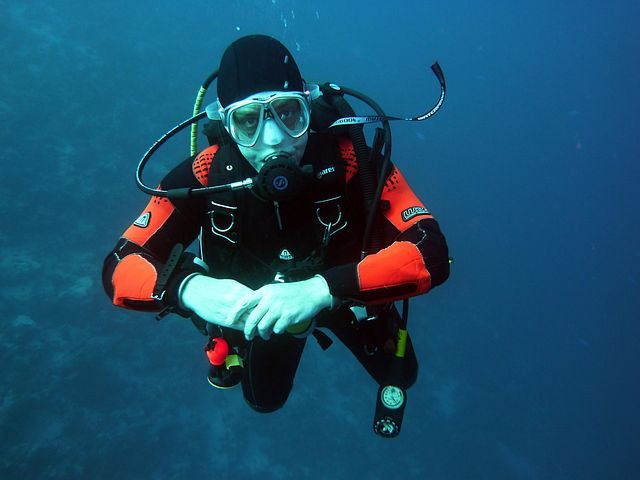Discover the secrets to effortless dives, better air consumption, and reef-safe diving.
Imagine descending into crystal-clear waters only to crash into the reef or kick up a cloud of silt. Your dive buddy signals “calm down,” but your trim is off, your breathing is erratic, and you’re bobbing like a cork. Every diver starts here. Somewhere, you remember someone saying, “Slow is smooth and smooth is fast.“
In this case, it is more about effectiveness and efficiency, not speed. But mastering buoyancy control isn’t just about looking cool underwater—it’s essential for safety, comfort, marine conservation, and maximizing your dive enjoyment.
In this ultimate guide, you’ll learn:
- The simple physics of buoyancy
- The best gear for buoyancy control
- Drills and tips to master buoyancy
- Common mistakes and how to fix them
- How to keep improving beyond your Open Water cert
The Physics of Buoyancy (Simplified)
Neutral buoyancy is the sweet spot where you neither sink nor float. It allows divers to hover mid-water effortlessly and glide through the ocean with minimal effort.
Let’s keep it simple:
-
- Positive buoyancy: You float
-
- Negative buoyancy: You sink
-
- Neutral buoyancy: You hover
This balance is achieved by adjusting your weight, fine-tuning your breath, and using your BCD (Buoyancy Control Device) properly. Archimedes’ Principle tells us that an object submerged in fluid is buoyed up by a force equal to the weight of the fluid displaced. In diving terms: if you’re too heavy, you’ll sink; too light, and you’ll float.
The main factors influencing buoyancy:
-
- Your total weight and distribution
-
- The amount of air in your BCD
-
- The amount of air in your lungs (yes, your lungs work like a mini-BCD!)
Gear Considerations for Buoyancy
BCD (Buoyancy Control Device)
Your BCD is your main buoyancy tool. Jacket-style BCDs are common among beginners, while wing-style options offer better trim and are favored by experienced divers.
-
- Ensure a proper fit: Too loose and it shifts around; too tight and you’ll feel restricted.
-
- Lift capacity matters: Make sure your BCD can compensate for your weight and equipment.
Recommended: [Affiliate Link Placeholder 1: Best Beginner BCD]
Weights
Proper weighting is everything.
-
- Too much weight = excess air needed in BCD, poor trim
-
- Too little weight = uncontrolled ascent
-
- Use integrated weights for convenience or a weight belt for adjustability
Do a pre-dive weight check:
-
- With a half-full tank, float at eye level with a full breath. Exhale, and you should slowly sink.
Regulator / Alternate Air Source
Your breathing directly affects buoyancy. Slow, deep breaths will make you rise; shallow ones will make you sink.
Wetsuit / Drysuit
Thicker wetsuits are more buoyant and compress with depth1. Drysuits also add buoyancy and require their own inflation control. Adjust accordingly.
Fins
Efficient fins and finning techniques help maintain balance without disturbing the environment.
-
- Frog kick is ideal for minimal disruption
-
- Flutter kick offers more propulsion
Mastering Buoyancy: Step-by-Step Drills & Techniques
1. Pre-Dive Weight Check
-
- Enter shallow water with half a tank
-
- Hold a normal breath at the surface
-
- You should float at eye level
-
- Exhale and begin to slowly descend
2. BCD Inflation/Deflation
-
- Add or release air in short bursts
-
- Always pause to check the result
-
- Never continuously inflate or deflate
3. Breath Control
-
- Inhale = rise
-
- Exhale = descend
-
- Practice controlling depth with your lungs only
4. Trim & Body Position
-
- Aim for a horizontal position
-
- Tuck your chin slightly, arms forward
-
- Keep knees bent slightly with fins elevated
5. Finning Techniques
-
- Use frog kicks for control
-
- Avoid sculling or using your hands
6. Hovering Drills
-
- In a pool or calm water, cross your legs, fold your arms, and hover
-
- Practice maintaining neutral buoyancy for 30 seconds, then a minute
Diagram Tip: Include an infographic titled “Perfect Dive Trim” showing correct horizontal posture.
Don’t forget to share this guide with a dive buddy!
Common Buoyancy Mistakes & How to Fix Them
-
- Over-weighting: Causes overuse of BCD and awkward posture
-
- Over/Under-inflating BCD: Small bursts, not large dumps
-
- Ignoring breath control: Leads to rollercoaster dives
-
- Poor trim: Standing upright adds drag and instability
-
- Panicked ascents/descents: Breathe slowly and control with breath and BCD
Beyond the Basics: Continuous Improvement
-
- Consider the Peak Performance Buoyancy specialty course
-
- Dive with experienced buddies and observe their techniques
-
- Log each dive: record what worked and what didn’t
-
- Reflect and practice consistently
Every dive is a learning opportunity.
Conclusion
Mastering buoyancy control is the turning point from being an “okay diver” to becoming a confident, eco-friendly, and skilled one. Better buoyancy means:
-
- Longer bottom time
-
- Lower air consumption
-
- Safer, more enjoyable dives
-
- A healthier marine environment
Whether you’re prepping for your next trip or just finished your Open Water course, now’s the time to take the leap from good to great.
- New science is developing, suggesting wetsuit compression characteristics may be misunderstood. ↩︎
Share your biggest buoyancy breakthrough in the comments below!




